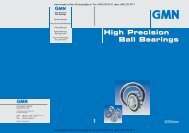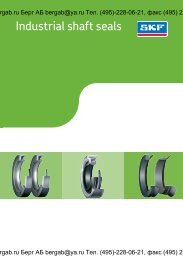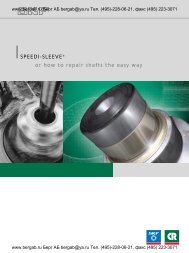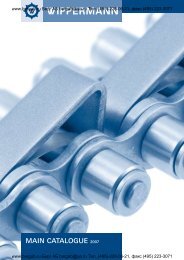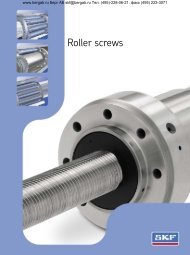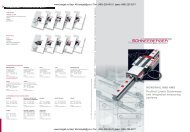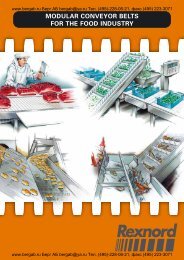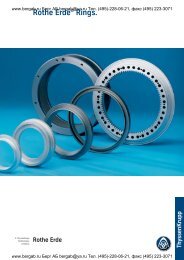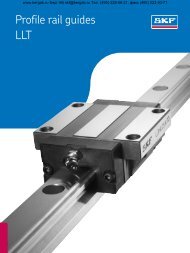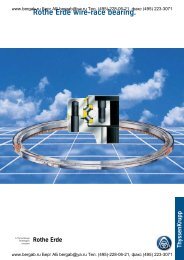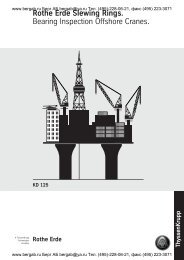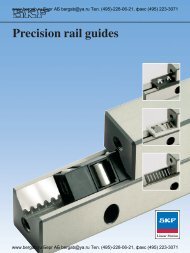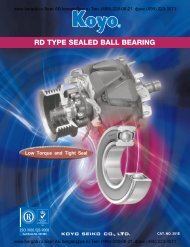You also want an ePaper? Increase the reach of your titles
YUMPU automatically turns print PDFs into web optimized ePapers that Google loves.
www.bergab.ru Берг АБ bergab@ya.ru Тел. (495)-228-06-21, факс (495) 223-3071<br />
SKF <strong>Multi</strong>-V <strong>Belt</strong> <strong>Kits</strong><br />
SKF now offers kits for auxiliary belt replacement. These kits offer quality<br />
<strong>and</strong> convenience when replacing belts that drive alternators, air conditioner<br />
compressors, etc.<br />
<strong>Multi</strong>-V <strong>Belt</strong> <strong>Kits</strong> include 1 auxiliary belt, 1 idler pulley, <strong>and</strong> 1 belt<br />
tensioner unit plus mounting instructions.<br />
Examine the old belt<br />
Looking closely at the condition of the belt you have removed can provide<br />
important clues about the drive system, for example, worn pulleys, partially or<br />
completed seized components, oil leakage, etc.<br />
Regardless of the condition of the belt, SKF recommends installing a new belt<br />
to assure maximum efficiency of the engine, <strong>and</strong> trouble-free operation for<br />
your customers.<br />
Removing <strong>and</strong> checking<br />
multi-V belts <strong>and</strong> pulley fittings<br />
Following are general guidelines for the replacement of multi-V or “serpentine”<br />
belts. Because every engine is different, please consult your workshop manual<br />
for more specific instructions.<br />
Getting started<br />
• Disconnect the battery leads.<br />
• Put the h<strong>and</strong>brake on.<br />
Technical Tips<br />
Use every service as an opportunity to add value to your customer<br />
relationships by checking the condition of the engine’s multi-V belts.<br />
They’ll appreciate your concern for their safety.<br />
Deposits of material in the ribs of a belt typically will not cause the<br />
belt to break but instead cause excessive noise <strong>and</strong> vibration. This<br />
condition can be caused by excessive slippage due to insufficient<br />
tension, misaligned pulleys, or worn pulley profiles.<br />
A mis-aligned pulley will typically cause cord popout, in which a<br />
section of cord appears at the side of the belt. This problem can be<br />
serious when the cord becomes tangles in a fixed component.<br />
• Before removing the old belt, observe the path of the belt on the various<br />
pulleys. Mark on the old belt the direction in which it is fitted, so you can<br />
install the new belt correctly.<br />
• Before removing the belt, check the alignment of the pulleys. (You will want<br />
to recheck the alignment after installing the new belt.)<br />
Eliminating belt tension<br />
• If the drive has an automatic belt tensioner spring, use the appropriate wrench<br />
to rotate the belt tightening pulley in the opposite direction from which it is<br />
stretched. Release the tension <strong>and</strong> block the tensioner by inserting a clamp pin<br />
in its place.<br />
• If the drive has an automatic hydraulic tensioner, release the tension by rotating<br />
the pulley, as described above. Remove the hydraulic tensioner <strong>and</strong> compress<br />
the small piston with a clamp until its opening corresponds to the hole on the<br />
base of the tensioner. Block the small piston with an appropriate pin.<br />
• Unscrew the stop nut(s) of the belt tensioner <strong>and</strong> remove the belt. If necessary,<br />
also unscrew the lock nut(s) of the alternator or other accessories driven by<br />
the multi-V belt.<br />
www.bergab.ru Берг АБ bergab@ya.ru Тел. (495)-228-06-21, факс (495) 223-3071



